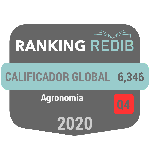Avaliação físico-química do húmus e composto como estratégia para fortalecer a agricultura sustentável
Resumo
A degradação do solo pela gestão antropogênica insustentável tem gerado a deterioração da qualidade e saúde do mesmo, por este motivo se buscam alternativas como o uso de adubos orgânicos para a reabilitação de suas funções ecológicas. Por isso, o presente estudo avaliou as propriedades físico-químicas do húmus e do composto produzidos na estação experimental Tunshi, Chimborazo, Equador, com o fim de validar sua idoneidade para a agricultura sustentável. Foram empregadas formulações baseadas em insumos locais, incluindo esterco de cobaia, restos vegetais, adubo verde e casca de arroz. As análises incluíram parâmetros como pH, condutividade elétrica (CE), matéria orgânica (MO) e macronutrientes, seguindo a normativa equatoriana NTE INEN 211:1998 e o manual técnico do INIAP. Os resultados revelaram que as formulações de composto e húmus cumprem com os padrões de qualidade, destacando-se a formulação F2 de composto e a formulação H2 para húmus com seu alto conteúdo de nitrogênio total e MO. As formulações de composto (F3) e húmus (H3) mostraram níveis superiores de fósforo e potássio, embora com menor conteúdo de nitrogênio, onde F2 (35 % esterco de cobaia, 25 % adubo verde) e H2 (50 % esterco de cobaia, 50 % restos vegetais) mostraram maior conteúdo de nitrogênio e MO, enquanto que em F3 (25 % esterco de cobaia, 30 % adubo verde) e H3 (40 % esterco de cobaia, 60 % restos vegetais), não existiram diferenças significativas nos parâmetros das formulações de húmus. Estes adubos representam uma alternativa agroecológica viável e sustentável para a reabilitação de solos degradados.
Downloads
Referências
AL-Kayssi, A.W. (2021). Use of water retention data and soil physical quality index S to quantify hard-setting and degree of soil compactness indices of gypsiferous soils. Soil and Tillage Research, 206, 104805. https://doi.org/10.1016/J.STILL.2020.104805
Amoah-Antwi, C., Kwiatkowska-Malina, J., Thornton, S.F., Fenton, O., Malina, G., & Szara, E. (2020). Restoration of soil quality using biochar and brown coal waste: A review. Science of the Total Environment, 722, 137852. https://doi.org/10.1016/J.SCITOTENV.2020.137852
Antonangelo, J.A., Sun, X., & Zhang, H. (2021). The roles of co-composted biochar (COMBI) in improving soil quality, crop productivity, and toxic metal amelioration. Journal of Environmental Management, 277, 111443. https://doi.org/10.1016/J.JENVMAN.2020.111443
Association of Official Analytical Chemists. (1984). Nitrogen (Total) in fertilizers. Modified combustion method (AOAC Official Method 978.02-1984). http://www.aoacofficialmethod.org/index.php?main_page=product_info&cPath=1&products_id=471
Awoonor, J.K., Amoakwah, E., Buri, M.M., Dogbey, B.F., & Gyamfi, J.K. (2025). Impact of land use on soil quality: Insights from the forest-savannah transition zone of Ghana. Heliyon, 11(1), e41183. https://doi.org/10.1016/J.HELIYON.2024.E41183
Bhattacharya, D., Tripathy, S., Swain, D.K., & Mitra, A. (2024). Can organic farming improve the soil properties, food quality and human health?. Food and Humanity, 3, 100398. https://doi.org/10.1016/J.FOOHUM.2024.100398
Bonilla-Bedoya, S., Valencia, K., Herrera, M.., López-Ulloa, M., Donoso, D.A., & Macedo Pezzopane, J.E. (2023). Mapping 50 years of contribution to the development of soil quality biological indicators. Ecological Indicators, 148, 110091. https://doi.org/10.1016/J.ECOLIND.2023.110091
Bünemann, E.K., Bongiorno, G., Bai, Z., Creamer, R.E., De Deyn, G., de Goede, R., Fleskens, L., Geissen, V., Kuyper, T.W., Mäder, P., Pulleman, M., Sukkel, W., van Groenigen, J.W., & Brussaard, L. (2018). Soil quality - A critical review. Soil Biology and Biochemistry, 120, 105-125. https://doi.org/10.1016/J.SOILBIO.2018.01.030
Chen, K., Li, J., Lin, L., Qin, W., Gao, Y., Hu, E., & Jiang, J. (2024). Occurrence, fate and control strategies of heavy metals and antibiotics in livestock manure compost land application: A review. Science of the Total Environment, 957, 177381. https://doi.org/10.1016/J.SCITOTENV.2024.177381
Dengiz, O., Alaboz, P., Saygın, F., Adem, K., & Yüksek, E. (2024). Evaluation of soil quality of cultivated lands with classification and regression-based machine learning algorithms optimization under humid environmental condition. Advances in Space Research, 74(11), 5514-5529. https://doi.org/10.1016/J.ASR.2024.08.048
Domínguez, J., & Gómez-Brandón, M. (2013). The influence of earthworms on nutrient dynamics during the process of vermicomposting. Waste Management & Research, 31(8), 859–868. https://doi.org/10.1177/0734242X13497079
Ebrahimi, M., Gholipour, S., Mostafaii, G., & Yousefian, F. (2024). Biochar-amended food waste compost: A review of properties. Results in Engineering, 24, 103118. https://doi.org/10.1016/J.RINENG.2024.103118
Eijsackers, H., & Maboeta, M. (2023). Pesticide impacts on soil life in southern Africa: Consequences for soil quality and food security. Environmental Advances, 13, 100397. https://doi.org/10.1016/J.ENVADV.2023.100397
Faverial, J., Boval, M., Sierra, J., & Sauvant, D. (2016). End-product quality of composts produced under tropical and temperate climates using different raw materials: A meta-analysis. Journal of Environmental Management, 183, 909-916. https://doi.org/10.1016/J.JENVMAN.2016.09.057
Feicán Mejía, C. (2011). Manual de producción de abonos orgánicos. Estación Experimental del Austro-INIAP. http://repositorio.iniap.gob.ec/handle/41000/2396
Feng, D., Cui, Y., Zeng, Y., Wang, D., Zhang, H., Zhang, Y., & Song, W. (2024). Enhancing compost quality through biochar and oyster shell amendments in the co-composting of seaweed and sugar residue. Chemosphere, 366, 143500. https://doi.org/10.1016/J.CHEMOSPHERE.2024.143500
García-Rández, A., Orden, L., Marks, E.A.N., Andreu-Rodríguez, J., Franco-Luesma, S., Martínez-Sabater, E., Saéz-Tovar, J.A., Pérez-Murcia, M.D., Agulló, E., Bustamante, M.A., Cháfer, M., & Moral, R. (2025). Monitoring of greenhouse gas emissions and compost quality during olive mill waste co-composting at industrial scale: The effect of N and C sources. Waste Management, 193, 33-43. https://doi.org/10.1016/J.WASMAN.2024.11.039
Hameed Ologunde, O., Kehinde Bello, S., & Abolanle Busari, M. (2024). Integrated agricultural system: A dynamic concept for improving soil quality. Journal of the Saudi Society of Agricultural Sciences, 23(5), 352-360. https://doi.org/10.1016/J.JSSAS.2024.03.002
Instituto Ecuatoriano de Normalización. (1997). Fertilizantes o abonos. Etiquetado. Requisitos (NTE INEN 221:1997, 1.ª revisión). https://www.agrocalidad.gob.ec/wp-content/uploads/2013/11/inen-0221-1997.pdf
Instituto Ecuatoriano de Normalización. (1998). Fertilizantes o Abonos. Tolerancias (NTE INEN 211:98). bit.ly/4mWmsJ9
International Organization for Standardization. (1994). Soil quality - Determination of phosphorus - Spectrometric determination of phosphorus soluble in sodium hydrogen carbonate solution (ISO 11263:1994). https://www.iso.org/standard/19241.html
International Organization for Standardization. (1995). Soil quality - Determination of total nitrogen - Modified Kjeldahl method (ISO 11261:1995). https://www.iso.org/standard/19239.html
International Organization for Standardization. (1998). Soil quality - Determination of organic carbon by sulfochromic oxidation (ISO 14235:1998). https://www.iso.org/standard/23140.html
Jiménez, L., Jiménez, W., González, L., Quichimbo, P., Fierro, N., & Capa-Mora, D. (2024). Rescuing local knowledge with regards to soil management and fertility in the Amazon region of Ecuador. Environmental Development, 50, 100984. https://doi.org/10.1016/J.ENVDEV.2024.100984
Kleemann, J., Koo, H., Hensen, I., Mendieta-Leiva, G., Kahnt, B., Kurze, C., Inclan, D.J., Cuenca, P., Noh, J.K., Hoffmann, M.H., Factos, A., Lehnert, M., Lozano, P., & Fürst, C. (2022). Priorities of action and research for the protection of biodiversity and ecosystem services in continental Ecuador. Biological Conservation, 265, 109404. https://doi.org/10.1016/J.BIOCON.2021.109404
Kong, Y., Zhang, J., Zhang, X., Gao, X., Yin, J., Wang, G., Li, J., Li, G., Cui, Z., & Yuan, J. (2024). Applicability and limitation of compost maturity evaluation indicators: A review. Chemical Engineering Journal, 489, 151386. https://doi.org/10.1016/J.CEJ.2024.151386
Kuria, A.W., Barrios, E., Pagella, T., Muthuri, C.W., Mukuralinda, A., & Sinclair, F.L. (2019). Farmers’ knowledge of soil quality indicators along a land degradation gradient in Rwanda. Geoderma Regional, 16, e00199. https://doi.org/10.1016/J.GEODRS.2018.E00199
Li, Y., Herbst, M., Chen, Z., Chen, X., Xu, X., Xiong, Y., Huang, Q., & Huang, G. (2024). Long term response and adaptation of farmland water, carbon and nitrogen balances to climate change in arid to semi-arid regions. Agriculture, Ecosystems & Environment, 364, 108882. https://doi.org/10.1016/J.AGEE.2023.108882
Manzano Vela, D.R., Ortega Castro, J.O., & Moya, A.E. (2024a). Caracterización fisicoquímica del biol en varias mezclas generadas por biodigestión. Recursos Naturales Producción y Sostenibilidad, 3(1), 35-51. https://doi.org/10.61236/renpys.v3i1.596
Manzano Vela, D.R., Villegas Freire, C.N., Zabala Vizuete, R.F., & Flores Mancheno, A.C. (2024b). Utilization of forest residues for cellulose extraction from timber species in the high montane forest of Chimborazo, Ecuador. Polymers, 16(19), 2713. https://doi.org/10.3390/POLYM16192713
Naderi-Boldaji, M., & Keller, T. (2016). Degree of soil compactness is highly correlated with the soil physical quality index S. Soil and Tillage Research, 159, 41-46. https://doi.org/10.1016/J.STILL.2016.01.010
Niedrite, E., Klavins, L., Dobkevica, L., Purmalis, O., Ievinsh, G., & Klavins, M. (2024). Sustainable control of invasive plants: Compost production, quality and effects on wheat germination. Journal of Environmental Management, 371, 123149. https://doi.org/10.1016/J.JENVMAN.2024.123149
Potthast, K., Hamer, U., & Makeschin, F. (2010). Impact of litter quality on mineralization processes in managed and abandoned pasture soils in Southern Ecuador. Soil Biology and Biochemistry, 42(1), 56-64. https://doi.org/10.1016/J.SOILBIO.2009.09.025
Rani, M., Kaushik, P., Bhayana, S., & Kapoor, S. (2023). Impact of organic farming on soil health and nutritional quality of crops. Journal of the Saudi Society of Agricultural Sciences, 22(8), 560-569. https://doi.org/10.1016/J.JSSAS.2023.07.002
Reyes-Torres, M., Oviedo-Ocaña, E.R., Domínguez, I., Komilis, D., & Sánchez, A. (2018). A systematic review on the composting of green waste: Feedstock quality and optimization strategies. Waste Management, 77, 486-499. https://doi.org/10.1016/J.WASMAN.2018.04.037
Sánchez-Cortez, J.L. (2019). Conservation of geoheritage in Ecuador: Situation and perspectives. International Journal of Geoheritage and Parks, 7(2), 91-101. https://doi.org/10.1016/J.IJGEOP.2019.06.002
Sánchez, Ó.J., Ospina, D.A., & Montoya, S. (2017). Compost supplementation with nutrients and microorganisms in composting process. Waste Management, 69, 136-153. https://doi.org/10.1016/j.wasman.2017.08.012
Satriani, A., Belviso, C., Lovelli, S., di Prima, S., Coppola, A., Hassan, S.B.M., Rivelli, A.R., & Comegna, A. (2024). Impact of a synthetic zeolite mixed with soils of different pedological characteristics on soil physical quality indices. Geoderma, 451, 117084. https://doi.org/10.1016/J.GEODERMA.2024.117084
Serri, D.L., Pérez-Brandan, C., Meriles, J.M., Salvagiotti, F., Bacigaluppo, S., Malmantile, A., & Vargas-Gil, S. (2022). Development of a soil quality index for sequences with different levels of land occupation using soil chemical, physical and microbiological properties. Applied Soil Ecology, 180, 104621. https://doi.org/10.1016/J.APSOIL.2022.104621
Tao, R., Cui, M., Li, Y., Wang, J., He, W., Zhao, Y., Xie, W., Shen, Y., Feng, Y., & White, J.C. (2024). Nanoscale biochar for fertilizer quality optimization in waste composting: Microbial community regulation. Bioresource Technology, 414, 131571. https://doi.org/10.1016/J.BIORTECH.2024.131571
Vasu, D., Tiwary, P., & Chandran, P. (2024). A novel and comprehensive soil quality index integrating soil morphological, physical, chemical, and biological properties. Soil and Tillage Research, 244, 106246. https://doi.org/10.1016/J.STILL.2024.106246
Vaz-Moreira, I., D’Arnese, A., Knoll, M., Teixeira, A.M., Barbosa, J.B., Teixeira, P., & Manaia, C.M. (2025). Bacteriological safety and quality of composted products from animal, urban or sewage sludge wastes. Environmental Pollution, 364, 125329. https://doi.org/10.1016/J.ENVPOL.2024.125329
Wang, S., Chen, D., Zhang, X., Xu, J., Lei, W., Zhou, C., Chen, C., Li, F., & Wang, N. (2019). Humus composition of mineral–microbial residue from microbial utilization of lignin involving different mineral types. Canadian Journal of Soil Science, 99(2), 208-216. https://doi.org/10.1139/CJSS-2018-0135
Wang, X., You, G., Liu, C., & Sun, Y. (2025). Bioaugmentation strategies in co-composting anaerobically digested food waste with agricultural by-products: Enhancing fertilizer quality and microbial communities. Ecotoxicology and Environmental Safety, 290, 117539. https://doi.org/10.1016/J.ECOENV.2024.117539
Wen, Y., Yao, W., Yu, T., Cheng, L., Zhang, Q., Yang, J., Lin, F., Zhu, H., Gunina, A., Yang, Y., Mganga, K.Z., Zeng, Z., & Zang, H. (2025). Long-term organic farming improves the red soil quality and microbial diversity in subtropics. Agriculture, Ecosystems & Environment, 381, 109410. https://doi.org/10.1016/J.AGEE.2024.109410
Yang, X., Yan, R., Li, S., Li, F., Yang, C., Zhang, H., Lyu, H., Liu, T., Zhou, L., Li, W., Duo, J., Li, R., & Yao, Y. (2024). Soil drives humus formation during composition of wheat straw and cattle manure. Journal of Environmental Chemical Engineering, 12(4), 113271. https://doi.org/10.1016/J.JECE.2024.113271
Yin, Z., Zhang, L., & Li, R. (2021). Effects of additives on physical, chemical, and microbiological properties during green waste composting. Bioresource Technology, 340, 125719. https://doi.org/10.1016/J.BIORTECH.2021.125719
Ziajahromi, S., & Leusch, F.D.L. (2022). Systematic assessment of data quality and quality assurance/quality control (QA/QC) of current research on microplastics in biosolids and agricultural soils. Environmental Pollution, 294, 118629. https://doi.org/10.1016/J.ENVPOL.2021.118629
Direitos de Autor (c) 2025 Dennis Renato Manzano Vela, Vicente Javier Parra León, Susana Monserrat Zurita Polo, Máyuri Viviana Pico Gordón

This work is licensed under a Creative Commons Attribution-NonCommercial-ShareAlike 4.0 International License.

















